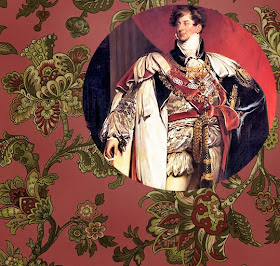Block 17 Waterwheel for Uncle James Leigh-Perrot
by Becky Brown
by Becky Brown
James Leigh-Perrot (1735-1817)
Jane Austen's uncle was her mother's brother, born James Leigh. At 21 he added great-uncle Perrot’s
name in order to inherit his estate.
name in order to inherit his estate.
The resort of Bath today.
Jane Austen visited several times and lived here
after her parents retired to the fashionable spa.
Uncle James and wife Jane Leigh-Perrot often visited Bath in hopes the
waters would cure his gout, a common diagnosis in Jane Austen’s England.
The Leigh-Perrots lived at #1 The Paragon.
The Austens visited them here.
Waterwheel by Georgann Eglinski
Cause & Effect
Red wine + rich diet = Gout
Gout is a specific type of arthritis caused
by an excess of uric acid, which crystallizes and temporarily settles in the
joints (often the big toe) causing much pain. Today about 6% of American men and 2% of women are afflicted by gout. Two hundred years ago it would seem that
every gentleman over the age of forty complained of the gout.
By Rowlandson from the Comforts of Bath series.
Treatment included
temporary abstinence from rich food and alcohol and a trip to a seaside
or hot springs resort. In 1811 Admiral
George Berkeley hoped “a considerable deal of fresh sea air, bathing and more
exercise [would] get rid of my rheumatic complaints, which really have almost crippled
me.” The thermal springs at Bath were considered quite beneficial, offering
relief in soaking the foot and drinking the mineral waters.
Henry Bunbury, Origin of the Gout
The gout epidemic in Georgian England was actually related
to status rather than science. A
diagnosis of gout had more cachet than rheumatism or similar arthritic
diseases. Gout is still considered diet-related, triggered by red wine and high
protein, red-meat diets, fare the lower classes did not enjoy. Gout seemed to
be the inevitable result of a gentleman’s life well-lived.
French cartoon characterizing the English as sots.
Another reason for over diagnosis is that a painful, swollen
foot is a symptom of worse diseases such as diabetes, liver, heart and kidney failure.
The doctors treating King George IV and politicians William Pitt the Younger
and Charles James Fox may have described the problem as gout, but the men likely
died of organ failure after years of alcohol abuse.
Waterwheel by Becky Brown
Waterwheel can remind us of the pumps, fountains and tubs at Bath. The pattern was published in the Farm Journal in the mid-20th-century.
BlockBase #1763d
If you're looking for it by number don't forget the d.
Cutting a 12” Block
A – Cut 16 squares 2-1/2”
B - Cut 4 squares 4-7/8”. Cut each in half
with a diagonal cut to make 2 triangles.
You need 8 triangles.
C – Cut 1 square 4-1/2”.
Sewing
Water Wheel by Bettina Havig
Links to more information.
See the book Gout: The
Patrician Malady by Dr. Roy Porter & G.S. Rousseau
Preview
And click here to read about Bath:























































